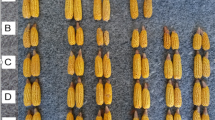Abstract
The fungicide Vitavax RS and the seed polymer Extender were sequentially applied to canola seed to determine their effect on the fungal inoculum, Penicillium bilaiae. In the laboratory, the fungicide was applied at the recommended rate of 23.4 ml kg−1, and the polymer was applied by the manufacturer. Significant death of P. bilaiae occurred after 2.5 days on the Vitavax RS-treated seed and after 1.5 days with the seed treated with both Vitavax RS and Extender. In field treatments, the seed was sown at six sites in the fall just prior to freeze-up. Results from the laboratory experiment indicate that there should be no harmful effects of the Vitavax RS and Extender on the P. bilaiae at the time of seeding because the seeds were sown within 2 h of inoculation. The environmental extremes in 2001 and 2002 resulted in large variations in the data. P. bilaiae did not increase yield under these conditions.


Similar content being viewed by others
References
Bashan Y, Holguin G, de-Bashan LE (2004) Azospirillium-plant relationships: physiological, molecular, agricultural, and environmental advances (1997–2003). Can J Plant Sci 50:521–577
Beckie HJ, Schlechte D, Moulin AP, Gleddie SC, Pulkien DA (1998) Response of alfalfa to inoculation with Penicillium bilaii (Provide). Can J Plant Sci 78:91–102
Cunningham JE, Kuiack C (1992) Production of citric and oxalic acids and solubilization of calcium phosphate by Penicillium bilaii. Appl Environ Microbiol 58:1451–1458
Curley RL, Burton JC (1975) Compatibility of Rhizobium japonicum with chemical seed protectants. Agron J 67:807–808
Dunfield KE, Siciliano SD, Germida JJ (2000) The fungicide thiram and captan affect the phenotypic characteristics of Rhizobium leguminosarum strain C1 as determined by FAME and Biolog analyses. Biol Fertil Soils 31:303–309
Environment Canada (2004) http://www.climate.weatheroffice.ec.gc.ca. Accessed 2004 August 25
Gleddie SC (1993) Response of pea and lentil to inoculation with the phosphate-solubilizing fungus Penicillium bilaii (Provide®). In: Proc. soils and crop workshop, Saskatoon, Saskatchewan, pp 47–52
Karamanos RE, Harapiak J, Flore NA (2002) Fall and early spring seeding of canola (Brassica napus L.) using different methods of seeding and P placement. Can J Plant Sci 82:21–26
Kirkland KJ, Johnson EN (2000) Alternative seeding dates (fall and April) affect Brassica napus canola yield and quality. Can J Plant Sci 80:713–719
Kucey RMN, Leggett ME (1989) Increased yields and P uptake by Westar canola (Brassica napus L.) inoculated with a phosphate-solubilizing isolate of Penicillium bilaji. Can J Soil Sci 69:425–432
Kyei-Boahen S, Slinkard AE, Walley FL (2001) Rhizobial survival and nodulation of chickpea as influenced by fungicide seed treatment. Can J Microbiol 47:585–589
Leggett M, Gleddie S, Holloway G (2001) Phosphate-solubilizing microorganisms and their use. In: Ae N et al (eds) Plant nutrient acquisition, new perspectives. Springer, Berlin Heidelberg New York, pp 299–318
Ramos MLG, Ribeiro WQ Jr (1993) Effect of fungicides on survival of Rhizobium on seeds and the nodulation of bean (Phaseolus vulgaris L.). Plant Soil 152:145–150
Revellin C, Leterme P, Catroux G (1993) Effect of some fungicide seed treatments on the survival of Bradyrhizobium japonicum and on the nodulation and yield of soybean [Glycine max. (L) Merr.]. Biol Fertil Soils 16:211–214
Vessey JK, Heisinger KG (2001) Effect of Penicillium bilaii inoculation and phosphorus fertilisation on root and shoot parameters of field-grown pea. Can J Plant Sci 81:361–366
Zablotowicz RM, Press CM, Lyng N, Brown GL, Kloepper JW (1992) Compatibility of plant growth promoting rhizobacterial strains with agrichemicals applied to seed. Can J Microbiol 38:45–50
Zaychuck KS, Enders N (2001) Water insoluble, freeze sensitive seed coatings. United States Patent number 6,230,438
Acknowledgements
This work was funded by Philom Bios Inc. and the Saskatchewan Canola Development Commission. We would like to thank Eric Hagele and Michelle Rudnicki at Philom Bios Inc. for their technical assistance.
Author information
Authors and Affiliations
Corresponding author
Rights and permissions
About this article
Cite this article
Burton, E.M., Knight, J.D. Survival of Penicillium bilaiae inoculated on canola seed treated with Vitavax RS and Extender. Biol Fertil Soils 42, 54–59 (2005). https://doi.org/10.1007/s00374-005-0862-7
Received:
Revised:
Accepted:
Published:
Issue Date:
DOI: https://doi.org/10.1007/s00374-005-0862-7




